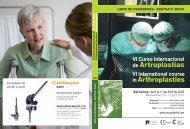cadera / hip - Active Congress.......
cadera / hip - Active Congress.......
cadera / hip - Active Congress.......
Create successful ePaper yourself
Turn your PDF publications into a flip-book with our unique Google optimized e-Paper software.
JUEVES / THURSDAY<br />
170<br />
increased by 29% (~7.5-8.0 Xbody weight); it<br />
increased by up to 37% with a displacement<br />
of 37 mm. This compared with a joint reaction<br />
force of 1.5 to 2.0 X body weight at the normal<br />
<strong>hip</strong> center. There was no increase in the joint<br />
reaction force with superior <strong>hip</strong> placement<br />
alone. Vertical placement of the acetabulum<br />
has been shown to have higher polyethylene<br />
wear rates as well.14,15 These factors may<br />
infl uence the rate of mechanical failure in<br />
metallic reinforcement devices. Udomkiat<br />
et al16 reported clinical and radiographic<br />
short-term results of 3 different metallic<br />
reconstruction devices (Burch–Schneider,<br />
Ganz, and Muller) for primarily type II and III<br />
defects. The overall mechanical failure rate,<br />
at an average of 4.6 years, was 17%. The<br />
Burch–Schneider cage had less favorable<br />
biomechanical characteristics than the other<br />
devices—abduction angles of 70.7 +12.6 and<br />
elevated <strong>hip</strong> centers of 16.6 +12.5 mm. Hip<br />
center lateralization was not documented,<br />
which could show an even more unfavorable<br />
biomechanical environment. The Ganz ring,<br />
with an inferior hook, had abduction angles<br />
of 61.9 +10.5 and elevated <strong>hip</strong> centers of<br />
12.6 +15.2 mm. No statistical analysis was<br />
documented on these parameters; however,<br />
there was no difference in the mechanical<br />
failure rate between the 3 devices. Their<br />
conclusions were that structural allograft, in<br />
contrast to particulate allograft, should be<br />
used in the superior portion of the acetabulum<br />
to prevent early failure. However, there<br />
was no consideration of the unfavorable<br />
biomechanical environment around the graft<br />
itself, which most likely contributed to early<br />
failure. In general, the surgical technique,<br />
particularly with the Burch–Schneider cage,<br />
focused on stabilizing the implant on host<br />
bone. This would lead, particularly with large<br />
defi ciencies, to superior and lateral <strong>hip</strong> center<br />
placement, which would explain a higher<br />
mechanical failure rate. In contrast, Kerboull<br />
et al7 reported a 10-year follow-up survivors<strong>hip</strong><br />
rate of 92.1 +5% for on type III and IV<br />
defi ciencies. The biomechanical parameters<br />
were more favorable, with a device abduc-<br />
tion angle of 38.7 +7.6. This device and the<br />
surgical technique focus on normal <strong>hip</strong> center<br />
orientation with an inferior crimping hook,<br />
similar to the Restoration GAP cup.<br />
However, the need to use structural allografts<br />
with gages does not provide immediate stability<br />
of the construct and relies on a favorable<br />
integration of the graft to the host bone which<br />
is not 100% predictable. Consequently, the<br />
introduction of new metals such as tantalum<br />
offer immediate stability of the implant and<br />
avoids premature failure of structural allografts18.<br />
References<br />
1. Lewallen DG, Berry DJ: Acetabular revision:<br />
Techniques and results, in Morrey<br />
BF (ed): Joint Replacement Arthroplasty.<br />
Philadelphia, Churchill Livingstone, 2003,<br />
pp 824-843.<br />
2. Paprosky WG, Perona PG, Lawrence JM:<br />
Acetabular defect classifi cation and surgical<br />
reconstruction in revision arthroplasty.<br />
J Arthroplasty 9:33-44, 1994<br />
3. D’Antonio JA, Capello WN, Borden LS,<br />
et al: Classifi cation and management of<br />
acetabular abnormalities in total <strong>hip</strong> arthroplasty.<br />
Clin Orthop 243:126-137, 1989<br />
4. Muller ME: Acetabular revision, in Salvati<br />
EA (ed): Proceedings of the Open Scientifi<br />
c Meeting of The Hip Society. St Louis,<br />
Mosby, 1981, pp 46-56<br />
5. Rosson J, Schatzker J: The use of reinforcement<br />
rings to reconstruct defi cient<br />
acetabula. J Bone Joint Surg 74B:716-<br />
720, 1992<br />
6. Berry DJ, Muller ME: Revision Arthroplasty<br />
using an anti-protrusio cage for massive<br />
acetabular bone defi ciency. J Bone Joint<br />
Surg 74B: 711-715, 1992<br />
7. Gill TJ, Siebenrock KA, Oberholzer R, et<br />
al: Acetabular reconstruction in develop-





